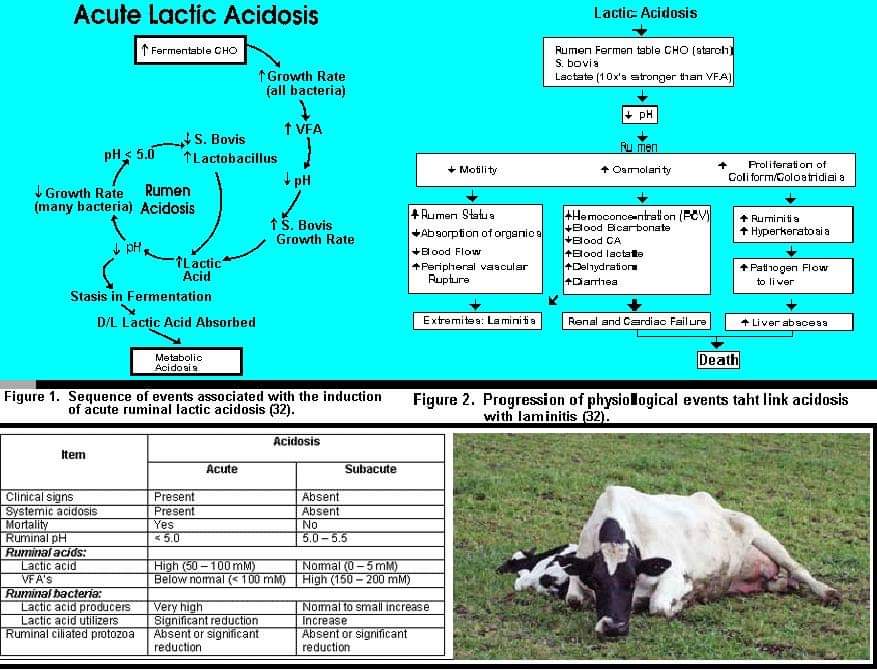Rumen Acidosis in Cattle – Treatment & Prevention
Rumen acidosis is a metabolic disease of cattle. Like most metabolic diseases it is important to remember that for every cow that shows clinical signs, there will be several more which are affected sub-clinically.
Acidosis is said to occur when the pH of the rumen falls to less than 5.5 (normal is 6.5 to 7.0). In many cases the pH can fall even lower. The fall in pH has two effects. Firstly, the rumen stops moving, becoming atonic. This depresses appetite and production.
Secondly, the change in acidity changes the rumen flora, with acid-producing bacteria taking over. They produce more acid, making the acidosis worse. The increased acid is then absorbed through the rumen wall, causing metabolic acidosis, which in severe cases can lead to shock and death.
Cause
The primary cause of acidosis is feeding a high level of rapidly digestible carbohydrate, such as barley and other cereals. Acute acidosis, often resulting in death, is most commonly seen in ‘barley beef’ animals where cattle have obtained access to excess feed. In dairy cattle, a milder form, sub-acute acidosis, is seen as a result of feeding increased concentrates compared to forage.
Symptoms
Acute acidosis often results in death, although illness and liver abscesses may be seen before hand. Cattle may become depressed, go off feed, have an elevated heart rate or diarrhea.
Sub-acute:
Reduced feed intake
Poor body condition and weight loss
Unexplained diarrhoea
Temperature
Pulse rate and respiratory rate may rise
Lethargy
Treatment
Because subacute ruminal acidosis is not detected at the time of depressed ruminal pH, there is no specific treatment for it. Secondary conditions may be treated as needed.
=> Thiamine is often a highly recommended injection to give to cattle with acute acidosis, as it is very important in treating and stopping a sudden acidosis attack. Acidosis very often halts the production of thiamine through digestion, and an injection of Thiamine will reverse this process.
=> Baking soda will also work as a treatment for cattle with acidosis.
=> it is believed that restricting water intake for the first 18–24 hr is helpful, although this has not been proven.
=>If overload is serious, slaughter for salvage should be considered
=>Removal of rumen contents and replacement with ingesta taken from healthy animals is necessary.
=> In animals that are still standing, rumenotomy is preferred to rumen lavage, because animals may aspirate during the lavage procedure and only rumenotomy ensures that all ingested grain has been removed.
=>Rumen lavage may be accomplished with a large stomach tube if sufficient water is available. A large-bore tube (2.5 cm inside diameter, 3 m long) should be used, and enough water added to distend the left paralumbar fossa; gravity flow is then allowed to empty out what it will. Repeating this 15–20 times achieves the same results
=>Fluid therapy to correct the metabolic acidosis and dehydration and to restore renal function. Initially, over a period of ∼30 min, 5% sodium bicarbonate solution should be given IV (5 L/450 kg). During the next 6–12 hr, a balanced electrolyte solution, or a 1.3% solution of sodium bicarbonate in saline, may be given IV, up to as much as 60 L/450 kg body wt.
=>Administer antacids PO (or intraruminally), particularly if IV sodium bicarbonate has been administered.
=>Procaine penicillin G should be administered IM to all affected animals for at least 5 days to minimize the development of bacterial rumenitis and liver abscesses.
=>Thiamine should also be administered IM to facilitate metabolism of l-lactate via pyruvate and oxidative phosphorylation; grain overload animals also have low concentrations of thiamine in rumen fluid due to the increased production of thiaminase by ruminal bacteria.
=>Next 2–4 days, good-quality hay and no grain should be given, and the grain then reintroduced gradually.
=> If good appetite returns within 3 days, the prognosis is good. However, if treatment was not started early enough to prevent acidification of the ruminal contents, and mycotic infection of the rumen wall ensues, relapse is likely within 3–5 days, and the prognosis is grave.
Prevention
The key to prevention is reducing the amount of readily fermentable carbohydrate consumed at each meal. This requires both good diet formulation (proper balance of fiber and nonfiber carbohydrates) and excellent feed bunk management. Animals consuming well-formulated diets remain at high risk for this condition if they tend to eat large meals because of excessive competition for bunk space or following periods of feed deprivation.
Feeding excessive quantities of concentrate and insufficient forage results in a fiber-deficient ration likely to cause subacute ruminal acidosis. The same situation may be seen during the last few days before parturition if the ration is fed in separate components.
Including long-fiber particles in the diet reduces the risk of subacute ruminal acidosis by encouraging saliva production during chewing and by increasing rumination after feeding. However, long-fiber particles should not be easily sorted away from the rest of the diet; this could delay their consumption until later in the day or cause them to be refused completely.
Ruminant diets should also be formulated to provide adequate buffering. This can be accomplished by feedstuff selection and/or by the addition of dietary buffers such as sodium bicarbonate or potassium carbonate. Dietary anion-cation difference is used to quantify the buffering capacity of a diet.
Supplementing the diet with direct-fed microbials that enhance lactate utilizers in the rumen may reduce the risk of subacute ruminal acidosis. Yeasts, propionobacteria, lactobacilli, and enterococci have been used for this purpose. Ionophore (eg, monensin sodium) supplementation may also reduce the risk by selectively inhibiting ruminal lactate producers.
Bovine Acidosis or Grain Overload
Bovine Acidosis or Grain Overload
Dr.S.Gangasudan, MVSc.,(VBC), Veterinary Assistant Surgeon, Muthupet, Tamilnadu, India




